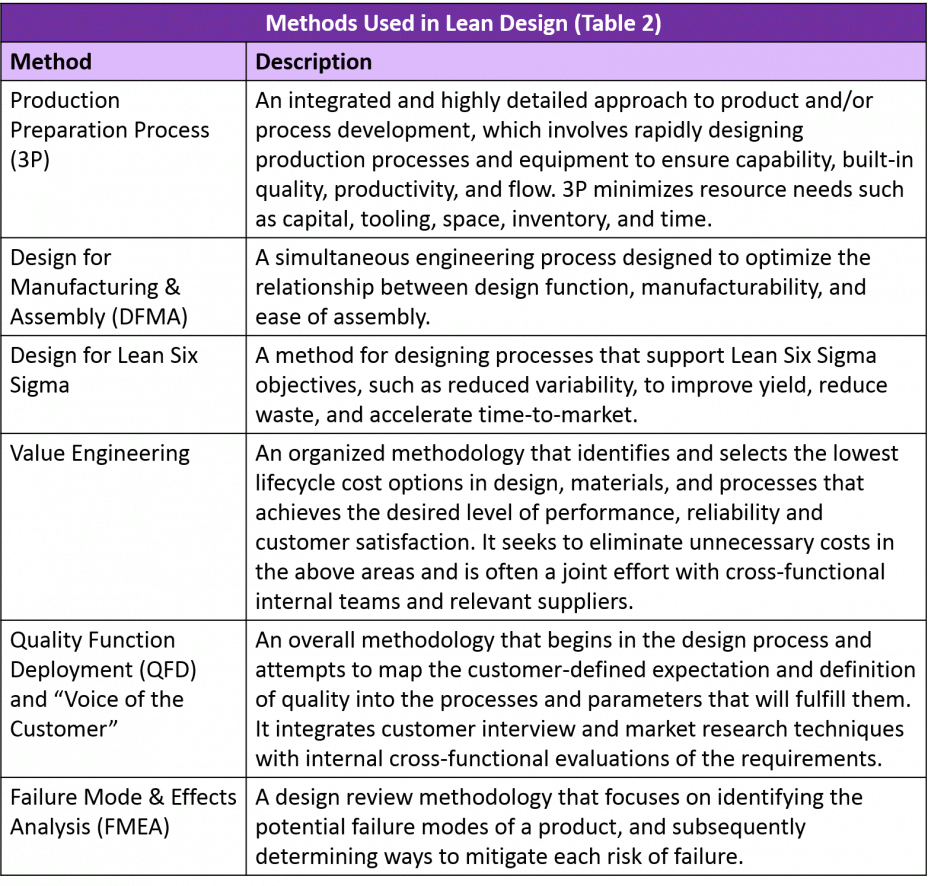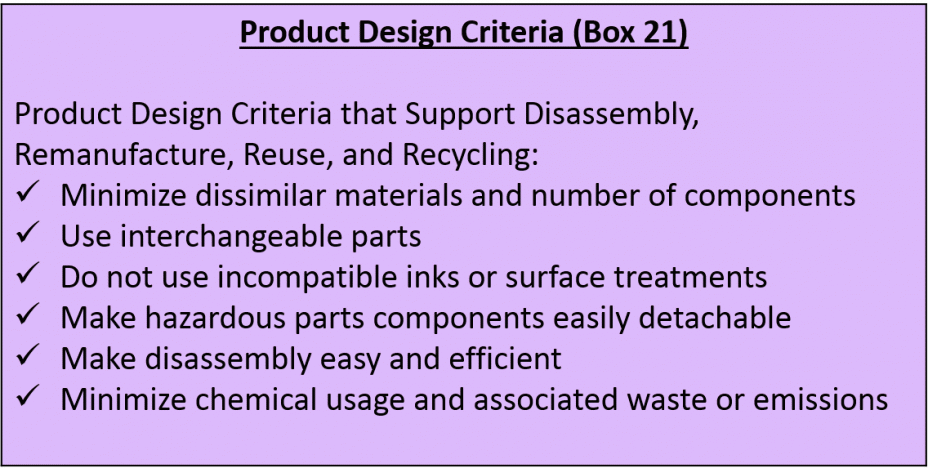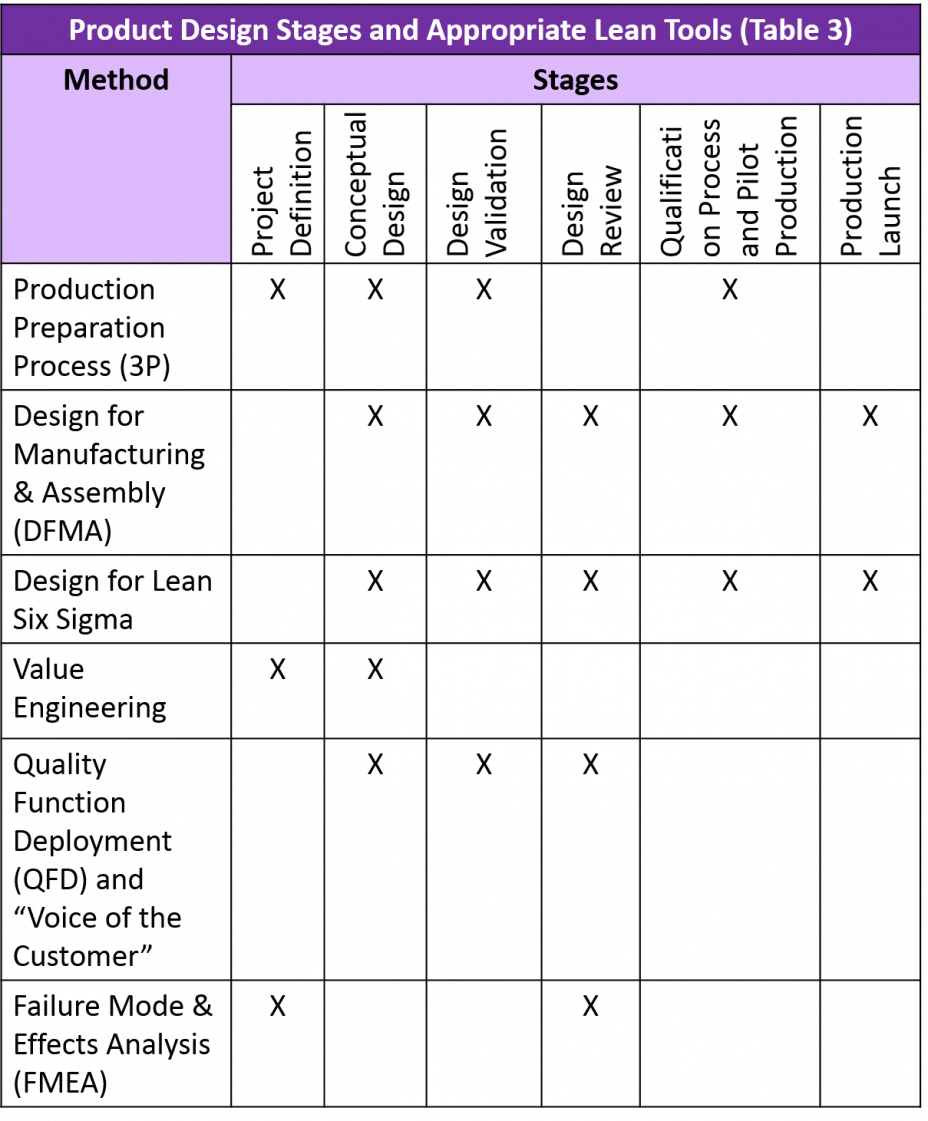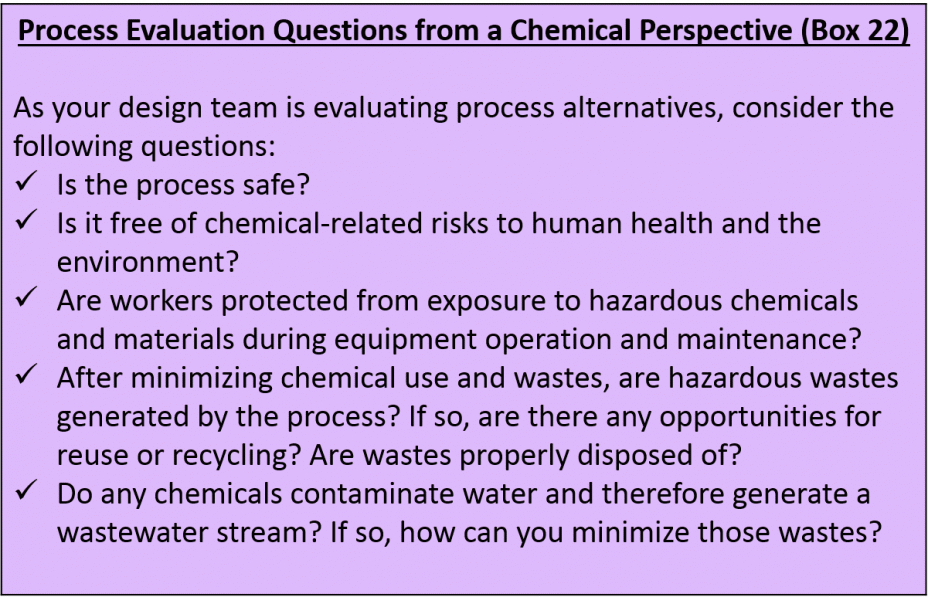Lean & Chemicals Toolkit: Chapter 6
Lean Product and Process Design Methods
- Introduction to Lean Product and Process Design
- Add Environmental Design Criteria to Lean Design Methods
- Draw on Design for the Environment Resources to Find Safer Alternatives
- Use Green Chemistry Principles When Designing Chemical Processes
- A Vision for Lean and Chemicals Efforts
- To Consider
- Footnotes
- Toolkit Navigation
Introduction to Lean Product and Process Design
Lean Product and Process Design Methods
![]() Lean design methods are a group of Lean tools and techniques that aim to:
Lean design methods are a group of Lean tools and techniques that aim to:
- Design (or redesign) high-quality products that meet customer needs with the least amount of waste (aspects that do not add value); and/or
- Design (or redesign) processes and equipment that add value to products using the least amount of time, material, and capital resources.
By examining the parts and processes that go into product development, Lean practitioners can identify and correct inefficiencies, improve quality, reduce costs, and potentially gain market advantage.
Lean practitioners use a variety of Lean tools for designing (or redesigning) products and processes. Some of these tools are also used in other types of Lean and Six Sigma improvement efforts (e.g., kaizen events). Table 2 describes several of these tools.
 The Lean method 3P—one of the most powerful and transformative Lean design methods—compresses the creative design process into a multi-day event. Steps in the 3P process include:
The Lean method 3P—one of the most powerful and transformative Lean design methods—compresses the creative design process into a multi-day event. Steps in the 3P process include:
- Define design objectives and form the project team
- Select key verbs to describe function
- Sketch and analyze examples from nature
- Identify at least seven ways of doing the operation
- Build, test, and evaluate the best alternatives (This is done rapidly in the context of an event and is often called “try storming” or “boot legging.”)
- Coordination (called “catch ball”) between product and process design teams (if applicable)
- Evaluate alternatives using design criteria
- Report out presentation and final development of the equipment or product
3P offers organizations the potential to make “quantum leap” improvements in performance, potentially including improvements that eliminate or minimize the use of hazardous chemicals in products and processes.
Product and Process Design Stages
There are six basic stages in the product development process, as follows.
- Project Definition: This stage explores all aspects of a proposed project to examine the relationship between activities, events, durations, and costs. Areas of uncertainty or conflict are identified, and possible alternatives or trade-offs are developed to strike a satisfactory balance.
- Conceptual Design: This stage describes how a new product will work and meet its performance requirements.
- Design Validation: A test is conducted in this stage to ensure that a product fulfills the defined user need and specified performance requirements.
- Design Review: In this stage, a systematic and comprehensive analysis of a design is conducted to determine its capability and adequacy to meet its requirements. During the design review, present and potential problems with the product can be identified.
- Qualification Process and Pilot Production: In this stage, a product is examined to ascertain that it meets required specifications and upon meeting those specifications, it becomes qualified. After a product is qualified, a production line is set up to produce a pilot product.
- Production Launch: This is the last stage in the product design and production process. In this stage, a product is produced by combining all the tangible and intangible inputs necessary to produce the product.
Table 3 shows which Lean tools are appropriate for different stages in the product development process.
Add Environmental Design Criteria to Lean Design Methods
Lean design methods often rely on a set of design criteria or principles for evaluating and ranking alternatives. Incorporating environmental design criteria into Lean design methods can help design teams reduce environmental risks in products (e.g., avoid using toxic chemicals) and ![]() environmental wastes throughout a product’s life cycle. For example, a U.S. furniture manufacturer incorporated environmental design principles, such as use of recyclable materials, into the product design criteria it used to develop a new, high-performance office chair using the 3P method. Box 21 outlines several product design criteria that minimize waste and support Lean and environmental objectives.
environmental wastes throughout a product’s life cycle. For example, a U.S. furniture manufacturer incorporated environmental design principles, such as use of recyclable materials, into the product design criteria it used to develop a new, high-performance office chair using the 3P method. Box 21 outlines several product design criteria that minimize waste and support Lean and environmental objectives.
 One important way to ensure that design teams consider potential environmental issues and incorporate precautions to protect worker
One important way to ensure that design teams consider potential environmental issues and incorporate precautions to protect worker ![]() health and safety is to involve environmental health and safety personnel in Lean design events and projects. The process evaluation questions in Box 22 below can also help guide Lean teams to design safer and less harmful processes.
health and safety is to involve environmental health and safety personnel in Lean design events and projects. The process evaluation questions in Box 22 below can also help guide Lean teams to design safer and less harmful processes.
Draw on Design for the Environment Tools and Resources to Find Safer Alternatives
![]() Design for the Environment (DfE) is an approach pioneered by industry for incorporating environmental and health considerations into the design and redesign of products and processes. Like Lean design methods such as 3P, DfE aims to eliminate wastes, uses nature as a model, and involves a systematic evaluation of alternatives-based actual performance data.
Design for the Environment (DfE) is an approach pioneered by industry for incorporating environmental and health considerations into the design and redesign of products and processes. Like Lean design methods such as 3P, DfE aims to eliminate wastes, uses nature as a model, and involves a systematic evaluation of alternatives-based actual performance data.
![]() EPA and other agencies have used DfE approaches to identify safer technologies and best practices for minimizing the environmental and human health impacts of different types of manufacturing processes. EPA’s Design for Environment Program partners with multiple industrial sectors that use and produce chemicals that are harmful to human health and the environment. Through this program, EPA has identified technology alternatives and best practices to help these sectors mitigate the risks of using hazardous chemicals. Example resources from EPA’s DfE program include:
EPA and other agencies have used DfE approaches to identify safer technologies and best practices for minimizing the environmental and human health impacts of different types of manufacturing processes. EPA’s Design for Environment Program partners with multiple industrial sectors that use and produce chemicals that are harmful to human health and the environment. Through this program, EPA has identified technology alternatives and best practices to help these sectors mitigate the risks of using hazardous chemicals. Example resources from EPA’s DfE program include:
- Lead-Solder Alternatives for Electronics: The DfE program has partnered with the electronics industry to evaluate the environmental impacts of tin-lead and lead-free solders. They developed the “Solders in Electronics: A Life-Cycle Assessment” report that contains the results of the potential environmental impacts of selected lead-free solders as alternatives to tin-lead solder.
- Safer Flame Retardants for Furniture: By partnering with the furniture industry, the DfE program is helping the industry factor environmental and human health considerations into their decision-making as they choose chemical flame retardants for fire safe furniture foam. This partnership developed “Environmental Profiles of Chemical Flame-Retardant Alternatives for Low-Density Polyurethane Foam” report that has information on safer alternatives to flame retardants currently in use.
- Best Practices for Auto Refinishing and Painting: The DfE program has also partnered with the automotive refinishing sector to increase awareness of the health and environmental concerns associated with refinishing activities and to encourage the use of best practices and safer, cleaner, more efficient practices and technologies. The DfE program has several technical documents available that provide guidance and advice on conventional and best practices for using paint in automotive refinishing.
In addition to these efforts, EPA’s DfE Program has many past partnerships with sectors such as:
- Adhesives technology
- Garment & textile care
- Industrial laundry and textile care
- Nail salons
- Printed circuit boards
- Printing industry
- Wire and cable
See Appendix A for additional resources related to reducing chemical use and finding safer alternatives to hazardous chemicals.
Use Green Chemistry Principles When Designing Chemical Processes
For businesses that manufacture chemicals or chemical products, consider using green chemistry principles in product design efforts to reduce additional wastes. Green chemistry is the design of chemical products and processes that reduce or eliminate the use or generation of hazardous substances. Green chemistry applies across the life cycle, including the design, manufacture, and use of a chemical product. Green chemistry technologies provide a number of benefits, including:
- Reduced waste, eliminating costly end-of-the-pipe treatments
- Safer products
- Potential reduced use of energy and resources
- Improved competitiveness of manufacturers and their customers
The following 12 Principles of Green Chemistry provide guidance on how to implement green chemistry concepts1.
- Prevent waste: Design chemical syntheses to prevent waste, leaving no waste to treat or clean up.
- Design safer chemicals and products: Design chemical products to be fully effective, yet have little or no toxicity.
- Design less hazardous chemical syntheses: Design syntheses to use and generate substances with little or no toxicity to humans and the environment.
- Use renewable feedstocks: Use raw materials and feedstocks that are renewable rather than depleting. Renewable feedstocks are often made from agricultural products or are the wastes of other processes. Depleting feedstocks are made from fossil fuels (petroleum, natural gas, or coal) or are mined.
- Use catalysts, not stoichiometric reagents: Minimize waste by using catalytic reactions. Catalysts are used in small amounts and can carry out a single reaction many times. They are preferable to stoichiometric reagents, which are used in excess and work only once.
- Avoid chemical derivatives: Making derivatives out of chemicals (e.g., use of blocking or protecting groups, or other temporary modifications) uses additional reagents and generates waste.
- Maximize atom economy: Design syntheses so that the final product contains the maximum proportion of the starting materials. There should be few, if any, wasted atoms.
- Use safer solvents and reaction conditions: Avoid using solvents, separation agents, or other auxiliary chemicals. If these chemicals are necessary, use innocuous chemicals.
- Increase energy efficiency: Run chemical reactions at ambient temperature and pressure whenever possible.
- Design chemicals and products to degrade after use: Design chemical products to break down to innocuous substances after use so that they do not accumulate in the environment.
- Analyze in real time to prevent pollution: Include in-process real-time monitoring and control during syntheses to minimize or eliminate the formation of byproducts.
- Minimize the potential for accidents: Design and use chemicals in appropriate phases (solid, liquid, or gas) to minimize the potential for chemical accidents, including explosions, fires, and releases to the environment.
EPA’s Green Chemistry Program and Sustainable Futures Program (see Box 23) provide many tools and resources for chemical manufacturers interested in incorporating green chemistry concepts into their product design processes. Appendix A describes a range of resources and tools for finding safer alternatives to hazardous chemicals; these resources are applicable to a broad range of facilities that use chemicals.
A Vision for Lean and Chemicals Efforts
As described in more detail in the Preface, a guiding vision for Lean and chemicals efforts could include the following two long-term goals:
- Produce high-quality products and services that do not contain hazardous chemicals that customers did not request.
- Develop products that can decompose naturally at the end of their use or become high-quality raw materials for new products.
These goals draw from the “cradle to cradle” design concepts outlined by William McDonough and Michael Braungart2. While all the strategies and tools in this toolkit can support these goals, leveraging Lean design methods to eliminate chemical wastes and integrate environmental design principles potentially offer the greatest opportunities to make radical or “quantum leap” improvements to help achieve this vision.
Footnotes
1 Paul Anastas and John Warner, Green Chemistry: Theory and Practice, Oxford University Press: New York, 1998.
2 William McDonough and Michael Braungart, Cradle to Cradle: Remaking the Way We Make Things, North Point Press, 2002.
Toolkit Navigation
- Contents & Acknowledgements
- Executive Summary
- Preface
- Chapter 1: Introduction
- Chapter 2: Chemicals Overview
- Chapter 3: Driving Out Chemical Waste with Lean Events
- Chapter 4: Chemical Management in the Lean Organization
- Chapter 5: Managing Chemicals in Lean Workspaces
- Chapter 6: Lean Product and Process Design Methods
- Chapter 7: Conclusion
- Appendix A: Chemical Resources
- Appendix B: Material Safety Data Sheet Template Example
- Appendix C: Point-of-Use Storage Request Form Example



